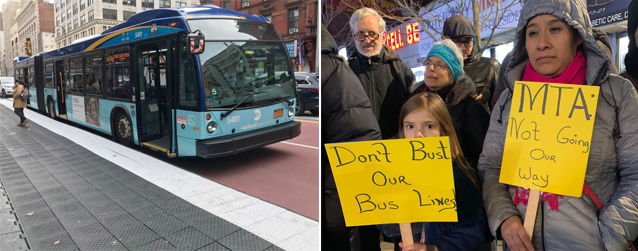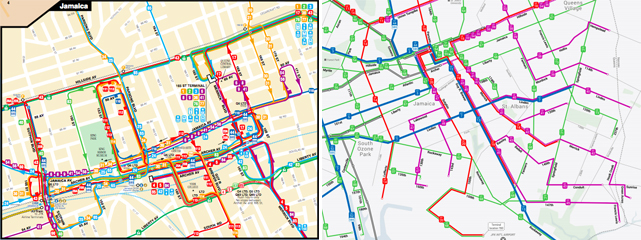The Winners And Losers in Queens Bus Network Redesign Draft
12:01 AM EST on January 14, 2020

The Queens bus network redesign may include priority routes like the 14th Street busway (left), but residents of Jackson Heights aren’t happy (right).
City & State NY is hosting a full day New York in Transit summit on Jan. 30 at the Museum of Jewish Heritage. This summit will bring together experts to assess the current state of New York’s transportation systems, break down recent legislative actions, and look towards the future of all things coming and going in New York. Join Keynote Speaker Polly Trottenberg, commissioner of the NYC Department of Transportation, along with agency leaders, elected officials, and advocates. Use the code STREETSBLOG for a 25-percent discount when you RSVP here!
OK, it's time to really look at the winners and losers of the MTA's Queens Bus Network redesign plan.
Crass? Maybe, but because the agency decided to make its redesign "revenue neutral," better service for some areas and riders is going to necessarily mean worse service for others.
Overall, the plan has been been lauded by many transit advocates — so that's good. But it's not perfect, as our analysis shows.
Bottom line: Queens elected officials are demanding changes.
"Whether it was intentional or not, they have chosen winners and losers," said City Council Member — and would-be Queens Borough President — Jimmy Van Bramer. "It's a Queens bus plan, which means it's gotta be for every single neighborhood and community. ... If you have a borough-wide perspective, you can't be in the business of making some communities very happy and other being set on fire."
Well, the MTA hasn't exactly committed arson across the Borough of Roses, but here's our analysis:
WINNERS
People going between LaGuardia Airport and the Bronx
Right now, if you wanted to get from the northeast Bronx to LaGuardia Airport, you would have to take the Q50 into Flushing and then transfer to the Q48. The proposed QT50 now offers a one-seat ride to LaGuardia, from Co-Op City, through Pelham and Throggs Neck and into Queens, serving almost 100,000 people and over 20,000 jobs within .25 miles of the bus stops.
Queens streets in general
Redesigning the bus network means more than just rerouting buses, it's also a good opportunity for the MTA and DOT to study the streets themselves to figure out where buses should be given the most priority. The result was a list of 49 roadways crisscrossing the borough that the DOT will study for potential improvements such as transit signal priority, bus lanes or even a new busway modeled off the successful one on 14th Street in Manhattan. The streets are broken into 21 primary corridors and 28 secondary corridors around the borough — and earned such a designation because they had a combination of high bus ridership and proposed route redesigns. The goal is to give the new network the best shot of working.
Bus riders going to and from the Jamaica transit hub

The current network around Jamaica's LIRR and and subway station (above left) is a swirling mess of colors representing over two dozen bus lines that twist and turn their way through a transit hub that serves millions of travelers per year. Those turns mean more chances for buses to get stuck behind cars making turns (in addition to making driving a bus far more dangerous). The draft plan reduces the chaos to 14 lines with spaced-out stops and more straight, direct routes in an attempt to speed up bus travel in the area, and still brings bus riders to the transit hub from all corners of Queens. There are also multiple priority corridors running through Jamaica, basically guaranteeing street treatments that clean up the notoriously traffic-choked area.
People who think a bus would be better than the BQX
Making good connections between western Queens and Brooklyn was a clear goal of the redesign, as seen in proposed routes like the QT1, QT2, QT4, QT54 and QT59 that lop off stubs of routes that take the buses further from Brooklyn or move in straighter lines and route new service through the previously-served areas in Queens. As a bonus, the QT1, which would run from Astoria to Downtown Brooklyn, closely mirrors the route of the BQX streetcar, as a commenter at Alon Levy's blog pointed out. Any excuse to not spend billions of dollars on a streetcar in a flood zone is a good one, and all the better if the reason is "We're moving more people, more cheaply, on a bus."
Eastern Queens residents trying to get to the subway
Residents of neighborhoods like Queens Village, Laurelton, Rosedale and Bayside currently live beyond the limits of the subway. Routes like the QT48, the QT43 or the QT36 are designed to more efficiently bring those residents to the subway by starting with stops that are near to each other in the subway deserts and then spaced out further for faster service as the buses approach subway and LIRR transfers. The goal is to expand the reach of the subway system without actually having to build new tunnels.
LOSERS
Jackson Heights
Debate is raging in the Streetsblog comments section as to whether the bus network redesign brutally screws over Jackson Heights or merely changes the focus of the bus service there. At the moment though, two things are definitely true: where multiple routes once took riders from East Elmhurst though Jackson Heights and to the 74th Street subway hub now only one (the QT61) does, and Jackson Heights residents can no longer get a one-seat ride to the Rockaways, which was a popular route during the summer. Even people who've praised the bus network redesign have asked the MTA to go back and take a look at the former issue, the QT74 for instance could potentially be extended to the 74th Street hub in order to keep the East Elmhurst connection alive that the Q49 currently provides, but restoring the one-seat ride to the Rockaways might be too much of a stretch given the plan's emphasis on simpler bus routes and travel via transfers.
Q18 and Q39 riders
Currently, the Q18 and Q39 buses, between Astoria and Long Island City and Ridgewood, respectively, have eight-minute headways during rush hour. The proposed QT80 combines those routes, lengthens the distance between stops and would make the peak headways every 20 minutes, which, last time we checked, is a longer wait time than eight minutes. On the other hand, MTA data does show that riders on those lines are waiting about an additional two and a half minutes longer than they should for those buses though, which would explain why the agency has 30th Avenue, which the QT80 will rely on, listed as one of the bus corridors to study for bus speed improvements.
The mayor
When the subways were in crisis last year, the public eventually fully realized that the governor, not the mayor, runs the MTA. Now it's payback time for the Big Dog in Albany, as eventually people are going to realize that the mayor can be held responsible if MTA buses are caught in traffic on streets controlled by his DOT. And in light of the success of the 14th Street busway, Mayor de Blasio will likely be criticized for being far too deliberate in planning the next wave of true bus priority routes through the boroughs. Indeed, even though the redesign relies heavily on the DOT making ambitious bus-first changes to city streets, this MTA draft plan for Queens does not include specific street improvements such as busways — and people are already seeing who's to blame for that. "I am disappointed that strong consideration for creating bus-only streets was not included," Queens City Council Member Costa Constantinides wrote in a letter to the city DOT and Andy Byford.
Sunday express bus riders
Express bus service provides trips between residential Queens and either downtown or Midtown Manhattan, but the MTA claims the routes have low-ridership on Sundays — with fewer than nine riders boarding per hour. But, as Cap'n Transit points out, New York City is still full of people who are trying to get around on Sundays, so why not give them options? What's next, banning dancing? And express bus ridership is not that much better on Saturdays — but that service wasn't cut.
If someone comes to the conclusion that express bus service is too expensive to run, fine. They want to cut it back to peak-only, maybe. But if you run service on Saturday, you damn well better run it on Sunday.https://t.co/vKt0dJCAzk
— Cap'n Transit (@capntransit) December 31, 2019
The MTA itself
The transit agency clearly anticipated that people would get mad about this plan, based on the inclusion of the question, "Can we just leave everything the way it is?" in its FAQ section of the plan. (Answer: "No. The current system is in dire need of change.") As with the Bronx bus network redesign, the MTA isn't getting extra money to add service on the reimagined bus lines, which means it was never going to be able to add service in one place without taking it away another place. A revenue-neutral bus redesign plan was always going to put agency officials in an impossible spot — but remember: they are the ones who decided improved bus service couldn't cost more than it currently does. "Revenue neutral" may be the original sin of this bus redesign.
The MTA is hosting multiple public forums about the bus redesign, beginning on Monday, Jan. 13. For the full schedule, click here.
Dave Colon is a reporter from Long Beach, a barrier island off of the coast of Long Island that you can bike to from the city. It’s a real nice ride. He’s previously been the editor of Brokelyn, a reporter at Gothamist, a freelance reporter and delivered freshly baked bread by bike. Dave is on Twitter as @davecolon. Email Dave Colon at dcolon@streetsblog.org
Read More:
Stay in touch
Sign up for our free newsletter
More from Streetsblog New York City
Thursday’s Headlines: Speed-Limiting Tech Edition
State Sen. Andrew Gounardes continues his push to force reckless drivers to install speed limiters in their cars. Plus more news.
DOT Official: All Our Free Parking Justifies Keeping Curb Space for EVs
If only someone could do something about the parking!
New York City to Install 500 Secure Bike Parking Hubs In The Next Five Years: Sources
Your bike may finally get a roof over its head.
Adams Backs Lower Speed Limits, Calls Crashes ‘Accidents’
The mayor wants New York City drivers to "slow down," but it's not clear yet how many streets will get lower speed limits.
Wednesday’s Headlines: Trump Posts About Congestion Pricing Edition
Donald Trump comments on congestion pricing — no surprise, he's against it. Plus more news.




